 |
|
Shaanxi 
|
|
|
|
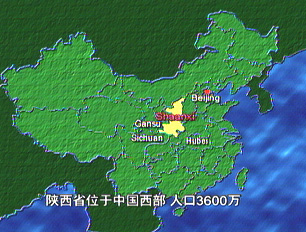 Historically the Chinese civilization originated from this beautiful and abundant land. Thirteen kingdoms and dynasties have established their capitals in Shaanxi, stretching over a period of 1,180 years and ensuring continued prosperity in the region. Compared with the rest of China, Shaanxi has had close contact with the outside world for a long period of time. Historically the Chinese civilization originated from this beautiful and abundant land. Thirteen kingdoms and dynasties have established their capitals in Shaanxi, stretching over a period of 1,180 years and ensuring continued prosperity in the region. Compared with the rest of China, Shaanxi has had close contact with the outside world for a long period of time.
Shaanxi province is located in western China and has a population of 36 million. The province covers an area of 205,600 square kilometres, and is 360 kilometres wide and spans 1,000 kilometres from north to south. The region is one of the major focuses in the West Development Project.
 The natural environment in Shaanxi varies considerably, with areas as diverse as the dignified Yellow Earth Plateau, the extensive Central Shaanxi Plain and the magnificent Qinling and Bashan Mountains. The Qinling Mountain is particularly important, it acts as a geological boundary that divides the north and south of China, and is the watershed between the Yellow and the Yangtze Rivers. The province has two different climate zones -- the temperate zone and the sub-tropical zone. Both the temperate climate and the diversified natural environment support many species of plants and animals. The natural environment in Shaanxi varies considerably, with areas as diverse as the dignified Yellow Earth Plateau, the extensive Central Shaanxi Plain and the magnificent Qinling and Bashan Mountains. The Qinling Mountain is particularly important, it acts as a geological boundary that divides the north and south of China, and is the watershed between the Yellow and the Yangtze Rivers. The province has two different climate zones -- the temperate zone and the sub-tropical zone. Both the temperate climate and the diversified natural environment support many species of plants and animals.
The Yellow River winds its way through Shaanxi.
 Huangling County in North Shaanxi is the final resting-place of the man considered to be the first ancestor of the Chinese nation, the Yellow Emperor. This tomb, now known as The Mausoleum of the Yellow Emperor, has become a symbol of the spirit of the Chinese nation. When Chinese people have been travelling overseas, they often return to Shaanxi province to pay homage at the Mausoleum. Huangling County in North Shaanxi is the final resting-place of the man considered to be the first ancestor of the Chinese nation, the Yellow Emperor. This tomb, now known as The Mausoleum of the Yellow Emperor, has become a symbol of the spirit of the Chinese nation. When Chinese people have been travelling overseas, they often return to Shaanxi province to pay homage at the Mausoleum.
There are an astounding 72 tombs of Chinese Emperors in Shaanxi. The largest tomb belongs to the first emperor of China, Emperor Qinshihuang.
 When Emperor Qinshihuang was alive he prayed to live forever, failing this he wanted to command the army and control the world even after his death. From 221 BC to 211 BC, 7,000 slaves were instructed to build an Army of 8,000 Terracotta Warriors as part of the Emperor’s underground kingdom. When Emperor Qinshihuang was alive he prayed to live forever, failing this he wanted to command the army and control the world even after his death. From 221 BC to 211 BC, 7,000 slaves were instructed to build an Army of 8,000 Terracotta Warriors as part of the Emperor’s underground kingdom.
Each year 2 million people from all corners of the globe flock to Shaanxi to see the miraculous sight of the Terracotta Army.
Shaanxi province has been dubbed the natural history museum of China. There are more than 30,000 historical sites, such as mausoleums, temples and relics, as well as 74 museums that hold 560,000 cultural relics.
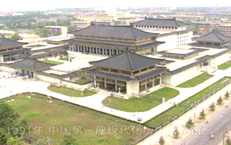 China’s first modern History Museum was established in 1991 in the capital of Shaanxi, Xi’an. The Shaanxi History Museum looks stately and imposing, combining classical architecture with an oriental modern style. The museum holds 370,000 cultural relics and it is one of the few museums that can display the entire Ancient Chinese History with its own collections. The historical sites of Shaanxi are the biggest attraction to foreign and domestic tourists, with tourism and related industries bringing considerable economic benefits to the area. While the local culture in Shaanxi such as embroidery, paper cuttings, shadow plays, Qin Opera and local food also benefit from exposure to the outside world. China’s first modern History Museum was established in 1991 in the capital of Shaanxi, Xi’an. The Shaanxi History Museum looks stately and imposing, combining classical architecture with an oriental modern style. The museum holds 370,000 cultural relics and it is one of the few museums that can display the entire Ancient Chinese History with its own collections. The historical sites of Shaanxi are the biggest attraction to foreign and domestic tourists, with tourism and related industries bringing considerable economic benefits to the area. While the local culture in Shaanxi such as embroidery, paper cuttings, shadow plays, Qin Opera and local food also benefit from exposure to the outside world.
Each year there are about 700,000 foreign tourists visiting the province. The two “must-dos” for any Shaanxi tourist include the Terracotta Warriors and the Qin Opera.
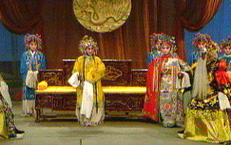 According to historical research, the Qin Opera began in the reign of Emperor Qinshihuang, it then developed further during the Han and Tang Dynasties and is still popular today. The Qin Opera has bold, strong and moving melodies, and conveys a sincere story or feeling. According to historical research, the Qin Opera began in the reign of Emperor Qinshihuang, it then developed further during the Han and Tang Dynasties and is still popular today. The Qin Opera has bold, strong and moving melodies, and conveys a sincere story or feeling.
There is a folk-lore that describes three prerequisites for the Qin Opera. The first is that the stage needs to be strong enough to withstand the rigors of the performance. The second states that the actors need to be very strong and healthy to sing the vigorous music. And thirdly the audience needs to be bold enough to sit through the whole opera.
Apart from Qin Opera the province has one classic folksong, the Xintianyou. This self-composed folksong is particularly popular among the villagers of the Yellow Earth Plateau. The song is a kind of companion to the farmers as they toil long hours in the unfertile fields, in a way it helps ease the isolation and hardship.
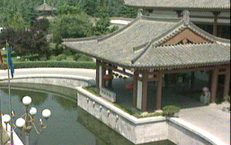 The long history and elegant culture is an unmistakable characteristic of Shaanxi, but the province is rapidly modernizing with many new technologies and innovations. The long history and elegant culture is an unmistakable characteristic of Shaanxi, but the province is rapidly modernizing with many new technologies and innovations.
 Shaanxi is a leader in the science and technology field not only in the western region, but also all over China. Additionally, the province is the second largest educational centre in China, with more than 40 colleges and universities, 2000 research institutes, and 50 national level key laboratories. With 35 members of the Chinese Academy of Sciences and the Chinese Academy of Engineering working in Shaanxi, there are a number of scientific and technological breakthroughs each year. This sturdy educational background provides the important base for the development of the region. Shaanxi is a leader in the science and technology field not only in the western region, but also all over China. Additionally, the province is the second largest educational centre in China, with more than 40 colleges and universities, 2000 research institutes, and 50 national level key laboratories. With 35 members of the Chinese Academy of Sciences and the Chinese Academy of Engineering working in Shaanxi, there are a number of scientific and technological breakthroughs each year. This sturdy educational background provides the important base for the development of the region.
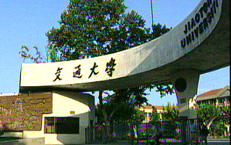 Xi'an Jiaotong University is one of the most famous educational institutes in the country. The University is more than 100 years old. It moved from Shanghai to its present campus in Xi’an in 1956. The aim of this change was to help the growth of education and in turn the industries in western China. Xi'an Jiaotong University is one of the most famous educational institutes in the country. The University is more than 100 years old. It moved from Shanghai to its present campus in Xi’an in 1956. The aim of this change was to help the growth of education and in turn the industries in western China.
Many departments in this university such as machinery and electronics are leaders in their field. Also, there are more than 10 national key laboratories and research centres based in the University, making this a strong science centre as well.
 Shaanxi is aiming to develop its science and technology industries, with a number of personnel nurturing programs, where budding scientists are being given incentives to produce and implement new and innovative ideas. The laser Rapid Prototyping and Manufacturing System Research Centre in Xi’an Jiaotong University is building prototypes of industry equipment using three dimensional computer technology. The centre is now building more Prototype machines, and selling them for use in the market place. Shaanxi is aiming to develop its science and technology industries, with a number of personnel nurturing programs, where budding scientists are being given incentives to produce and implement new and innovative ideas. The laser Rapid Prototyping and Manufacturing System Research Centre in Xi’an Jiaotong University is building prototypes of industry equipment using three dimensional computer technology. The centre is now building more Prototype machines, and selling them for use in the market place.
The strength of the science and technology industry in Shaanxi provides a huge potential for development. With the West China Development Project underway, Shaanxi should use its educational advantages to realize its growth potential.
|
|
Editor:Liu Baoyin CCTV.com
|
|
|
|
|
|
 |









